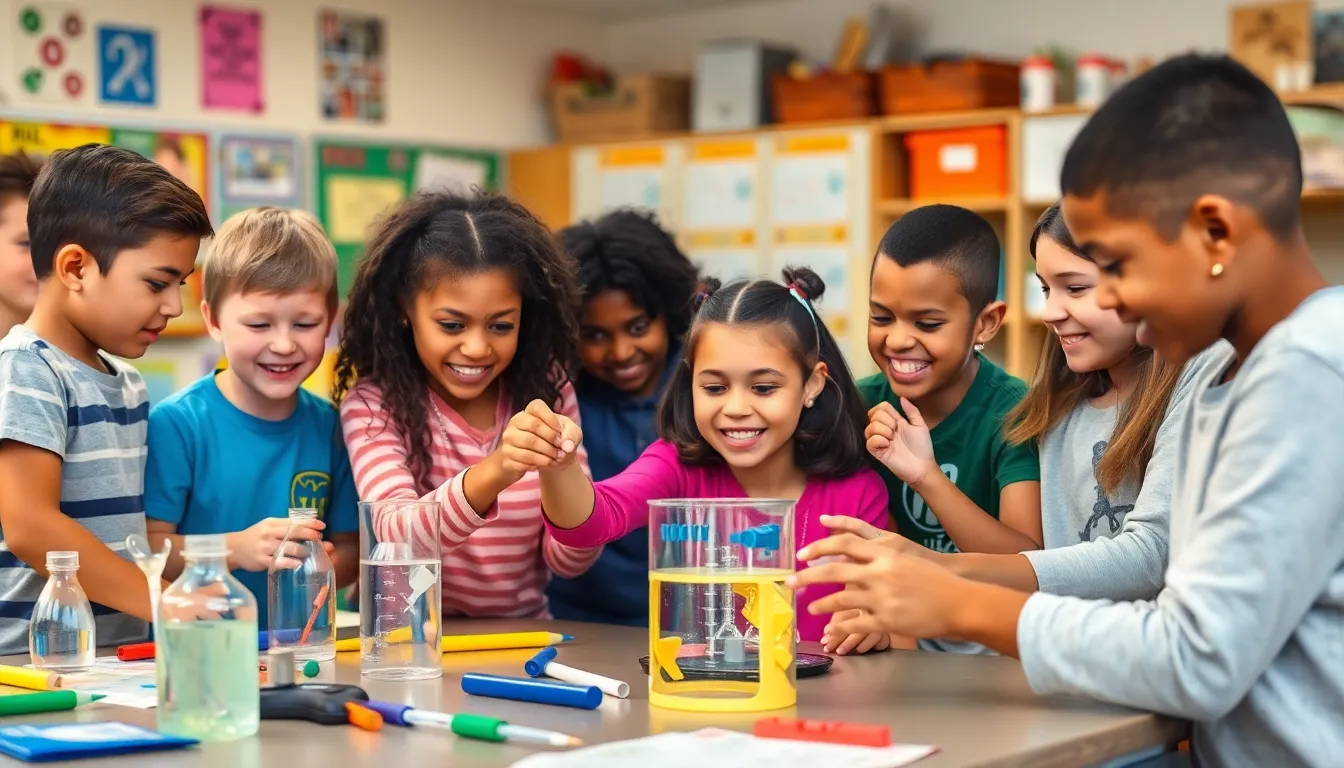Table of Contents
ToggleClassroom activities play a crucial role in shaping the educational experience. They not only enhance learning but also foster engagement and collaboration among students. By incorporating a variety of activities, teachers can cater to different learning styles and keep students motivated throughout the school year.
From hands-on projects to interactive discussions, effective classroom activities encourage critical thinking and creativity. These experiences help students develop essential skills like teamwork and communication, preparing them for future challenges. As educators seek innovative ways to enrich their lessons, the right classroom activities can make all the difference in creating a dynamic and inspiring learning environment.
Overview of Classroom Activities
Classroom activities encompass a range of strategies designed to engage students and enhance the learning experience. These activities include collaborative projects, interactive discussions, hands-on experiments, and creative assignments. Each type of activity serves a specific learning objective and caters to diverse learning styles.
Types of Classroom Activities
- Collaborative Projects
Collaborative projects involve students working together to achieve a common goal. These projects promote teamwork, enhance communication skills, and foster a sense of community within the classroom. Examples include group presentations and research projects.
- Interactive Discussions
Interactive discussions encourage students to express their thoughts and ideas on a topic. This method stimulates critical thinking and helps students develop their argumentative skills. Examples include class debates and Socratic seminars.
- Hands-On Experiments
Hands-on experiments provide students with real-world applications of theoretical concepts. They promote engagement and curiosity, making learning more tangible. Examples include science lab experiments and art projects.
- Creative Assignments
Creative assignments allow students to explore their imagination while reinforcing subject matter. This approach enables learners to demonstrate understanding in innovative ways. Examples include writing stories, creating artwork, and producing videos.
Benefits of Classroom Activities
Classroom activities contribute to a dynamic learning environment by:
- Enhancing Engagement: Activities capture students’ interest, making lessons more enjoyable and memorable.
- Fostering Collaboration: Group work cultivates communication skills and prepares students for future teamwork scenarios.
- Supporting Diverse Learning Styles: Various activities address auditory, visual, and kinesthetic learners, ensuring all students can thrive.
- Encouraging Critical Thinking: Interactive tasks challenge students to analyze information and develop reasoned conclusions.
Incorporating a mix of these activities significantly enriches the educational experience and prepares students for real-world challenges.
Benefits of Engaging Classroom Activities


Engaging classroom activities deliver numerous advantages that enhance the educational experience. These activities play a pivotal role in fostering active participation and improving overall learning outcomes.
Enhancing Student Participation
Engaging classroom activities actively involve students in their learning processes. Activities such as group discussions, hands-on projects, and role-playing increase student interest and motivation. When students participate in meaningful tasks, they demonstrate higher levels of engagement. Research shows that increased participation leads to improved retention of information. Teachers observe that students who are actively involved tend to ask questions, share ideas, and collaborate effectively with peers, creating a vibrant classroom environment.
Improving Learning Outcomes
Engaging classroom activities correlate directly with improved learning outcomes. When students engage in interactive tasks, they develop a deeper understanding of the material. Activities like experiments and simulations enable students to apply theories practically, promoting critical thinking. Studies indicate that students who participate in experiential learning achieve higher academic performance. Additionally, diverse activities support various learning styles, ensuring that all students can access the curriculum effectively. By integrating various activities, teachers can create a dynamic learning atmosphere that nurtures essential skills and prepares students for future challenges.
Types of Effective Classroom Activities
Effective classroom activities encompass a variety of methods that enhance learning experiences. These activities engage students, promote teamwork, and reinforce important skills.
Group Work and Collaborative Projects
Group work and collaborative projects foster communication and teamwork among students. In these activities, students work together to achieve common goals, enhancing their problem-solving abilities. For instance, group presentations require students to research, organize, and present information collectively, reinforcing understanding of the subject matter. Additionally, these projects promote accountability, as each member contributes to the final outcome. Research shows that students engaged in group work demonstrate improved interpersonal skills and higher levels of retention.
Interactive Games and Simulations
Interactive games and simulations provide engaging ways for students to apply their knowledge in practical situations. These activities stimulate critical thinking and decision-making skills through real-world scenarios. For example, role-playing activities allow students to assume different perspectives, enhancing empathy and understanding of diverse viewpoints. Furthermore, educational games can make complex concepts more accessible, encouraging active participation and motivation. Studies indicate that students participating in gamified learning environments exhibit increased engagement and better academic performance.
Tips for Implementing Classroom Activities
Effective implementation of classroom activities requires strategic planning to align with educational goals and promote a positive learning environment. Below are key strategies for successful execution.
Aligning Activities with Curriculum Goals
- Identify Objectives: Identify specific learning objectives for each subject. Ensure classroom activities directly support these objectives to maintain focus.
- Integrate Standards: Integrate state or national standards into activities. This alignment ensures that students meet academic requirements while engaging in meaningful learning experiences.
- Use Assessment Criteria: Use assessment criteria based on curriculum goals. Clearly defined criteria help students understand evaluation methods, enhancing accountability.
- Adapt Activities: Adapt activities based on student progress. Monitor learning outcomes and adjust activities to address areas needing improvement or reinforcement.
Encouraging Inclusivity and Participation
- Foster a Safe Environment: Foster a safe learning environment where every student feels comfortable to participate. Establishing ground rules encourages open communication and mutual respect.
- Vary Group Dynamics: Vary group dynamics by frequently changing groups. This practice allows students to collaborate with different peers, enhancing social skills and reducing cliques.
- Incorporate Diverse Learning Styles: Incorporate diverse learning styles into activities. Use visual, auditory, and kinesthetic elements to cater to all students, ensuring everyone can engage meaningfully.
- Provide Multiple Roles: Provide multiple roles within group activities. Assign various responsibilities, enabling each student to contribute their strengths and promoting a sense of belonging.







